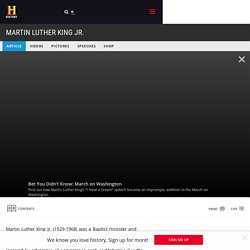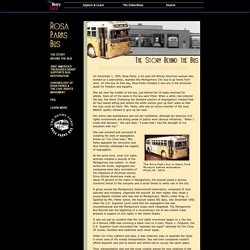

Martin Luther King Jr. - Biography - Civil Rights Activist, Minister. Rodney King - Biography - - Biography.com. When a mostly white jury acquitted the police officers who were caught on video beating Rodney King, it set off the L.A. riots of 1992.

Synopsis Born in Sacramento, California, on April 2, 1965, Rodney King was caught by the Los Angeles police after a high-speed chase on March 3, 1991. The officers pulled him out of the car and beat him brutally, while amateur cameraman George Holliday caught it all on videotape. The four L.A.P.D. officers involved were indicted on charges of assault with a deadly weapon and excessive use of force by a police officer. However, after a three-month trial, a predominantly white jury acquitted the officers, inflaming citizens and sparking the violent 1992 Los Angeles riots.
Beating by LAPD Born on April 2, 1965, in Sacramento, California, Rodney Glen King was an African American who became a symbol of racial tension in America, after his beating by Los Angeles police officers in 1991 was videotaped and broadcast to the nation. Acquittal and Resulting Riots. Dick Gregory - Biography - Civil Rights Activist, Comedian - Biography.com. Martin Luther King Jr. - Black History.
The second child of Martin Luther King Sr. (1899-1984), a pastor, and Alberta Williams King (1904-1974), a former schoolteacher, Martin Luther King Jr. was born in Atlanta, Georgia, on January 15, 1929.

Along with his older sister, the future Christine King Farris (born 1927), and younger brother, Alfred Daniel Williams King (1930-1969), he grew up in the city’s Sweet Auburn neighborhood, then home to some of the most prominent and prosperous African Americans in the country. A gifted student, King attended segregated public schools and at the age of 15 was admitted to Morehouse College, the alma mater of both his father and maternal grandfather, where he studied medicine and law. Although he had not intended to follow in his father’s footsteps by joining the ministry, he changed his mind under the mentorship of Morehouse’s president, Dr. Benjamin Mays, an influential theologian and outspoken advocate for racial equality. Black Like Me: Characters.
Rosa Parks Bus - The Story Behind the Bus. On December 1, 1955, Rosa Parks, a 42-year-old African American woman who worked as a seamstress, boarded this Montgomery City bus to go home from work.

On this bus on that day, Rosa Parks initiated a new era in the American quest for freedom and equality. She sat near the middle of the bus, just behind the 10 seats reserved for whites. Soon all of the seats in the bus were filled. When a white man entered the bus, the driver (following the standard practice of segregation) insisted that all four blacks sitting just behind the white section give up their seats so that the man could sit there. Mrs. Her action was spontaneous and not pre-meditated, although her previous civil rights involvement and strong sense of justice were obvious influences. She was arrested and convicted of violating the laws of segregation, known as “Jim Crow laws.” Black History Month — History.com Articles, Video, Pictures and Facts.
The story of Black History Month begins in 1915, half a century after the Thirteenth Amendment abolished slavery in the United States.

That September, the Harvard-trained historian Carter G. Woodson and the prominent minister Jesse E. Moorland founded the Association for the Study of Negro Life and History (ASNLH), an organization dedicated to researching and promoting achievements by black Americans and other peoples of African descent. Known today as the Association for the Study of African American Life and History (ASALH), the group sponsored a national Negro History week in 1926, choosing the second week of February to coincide with the birthdays of Abraham Lincoln and Frederick Douglass. The event inspired schools and communities nationwide to organize local celebrations, establish history clubs and host performances and lectures. In the decades that followed, mayors of cities across the country began issuing yearly proclamations recognizing Negro History Week. Rosa Parks Biography. Martin Luther King, Jr. and African American History.
Rosa Parks: How I Fought for Civil Rights. The Black Panthers. The Black Panthers were formed in California in 1966 and they played a short but important part in the civil rights movement.

The Black Panthers believed that the non-violent campaign of Martin Luther King had failed and any promised changes to their lifestyle via the 'traditional' civil rights movement, would take too long to be implemented or simply not introduced. The language of the Black Panthers was violent as was their public stance. The two founders of the Black Panther Party were Huey Percy Newton and Bobby Seale. They preached for a "revolutionary war" but though they considered themselves an African-American party, they were willing to speak out for all those who were oppressed from whatever minority group.
They were willing to use violence to get what they wanted. The Black Panther Party (BPP) had four desires : equality in education, housing, employment and civil rights.